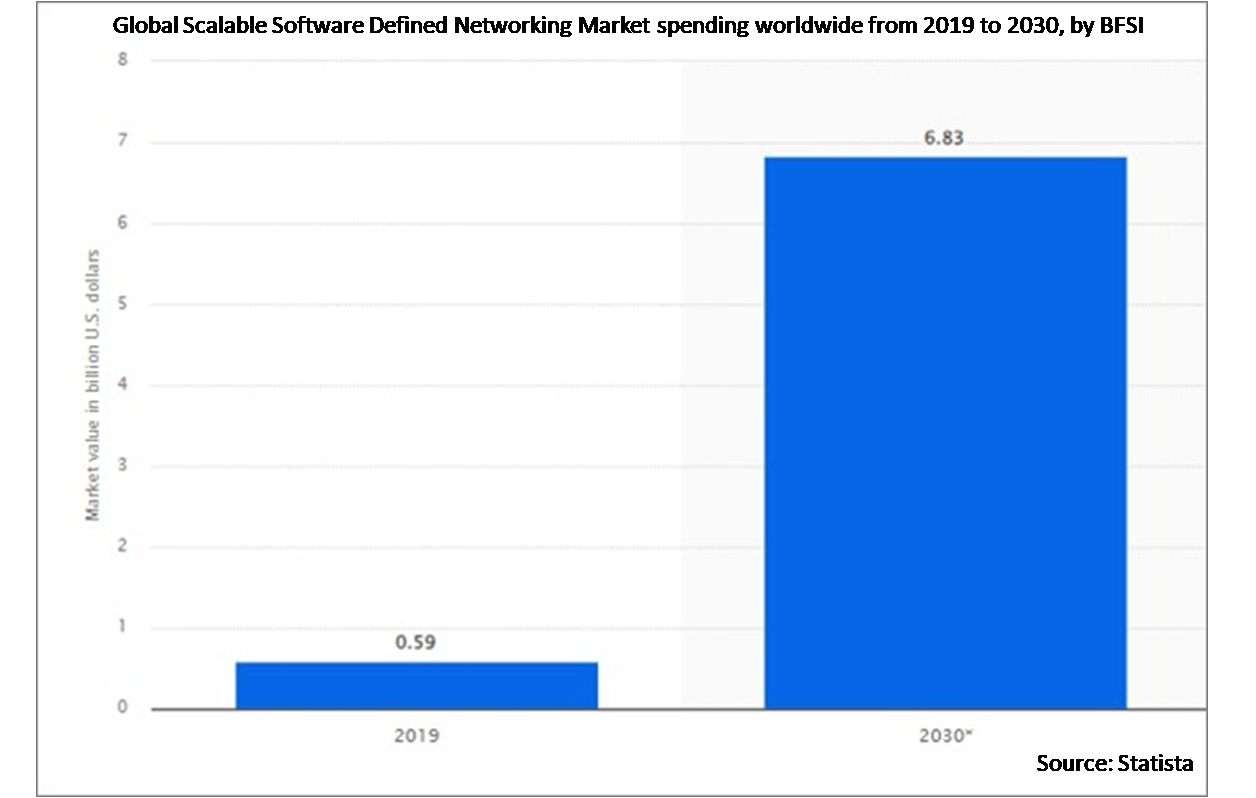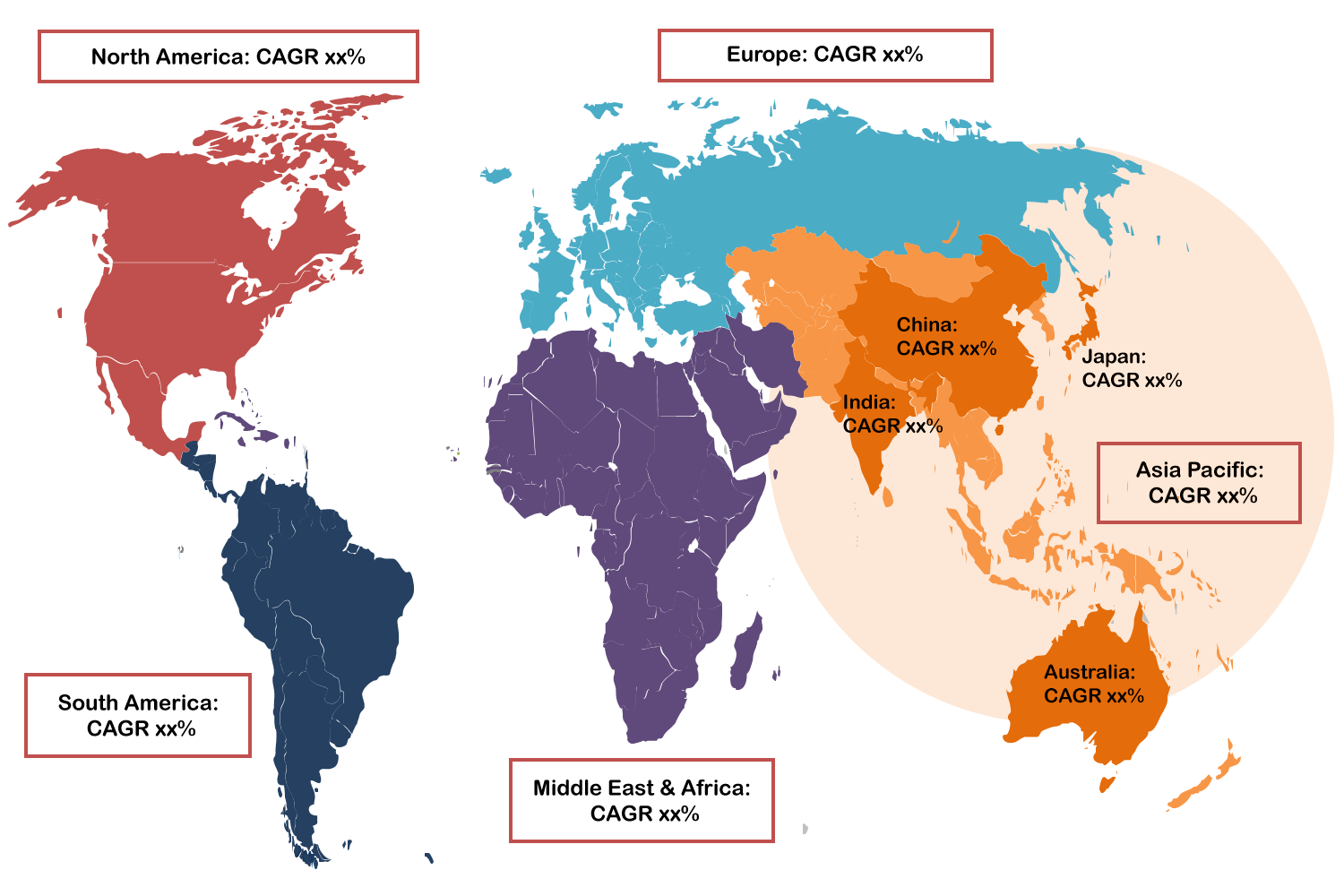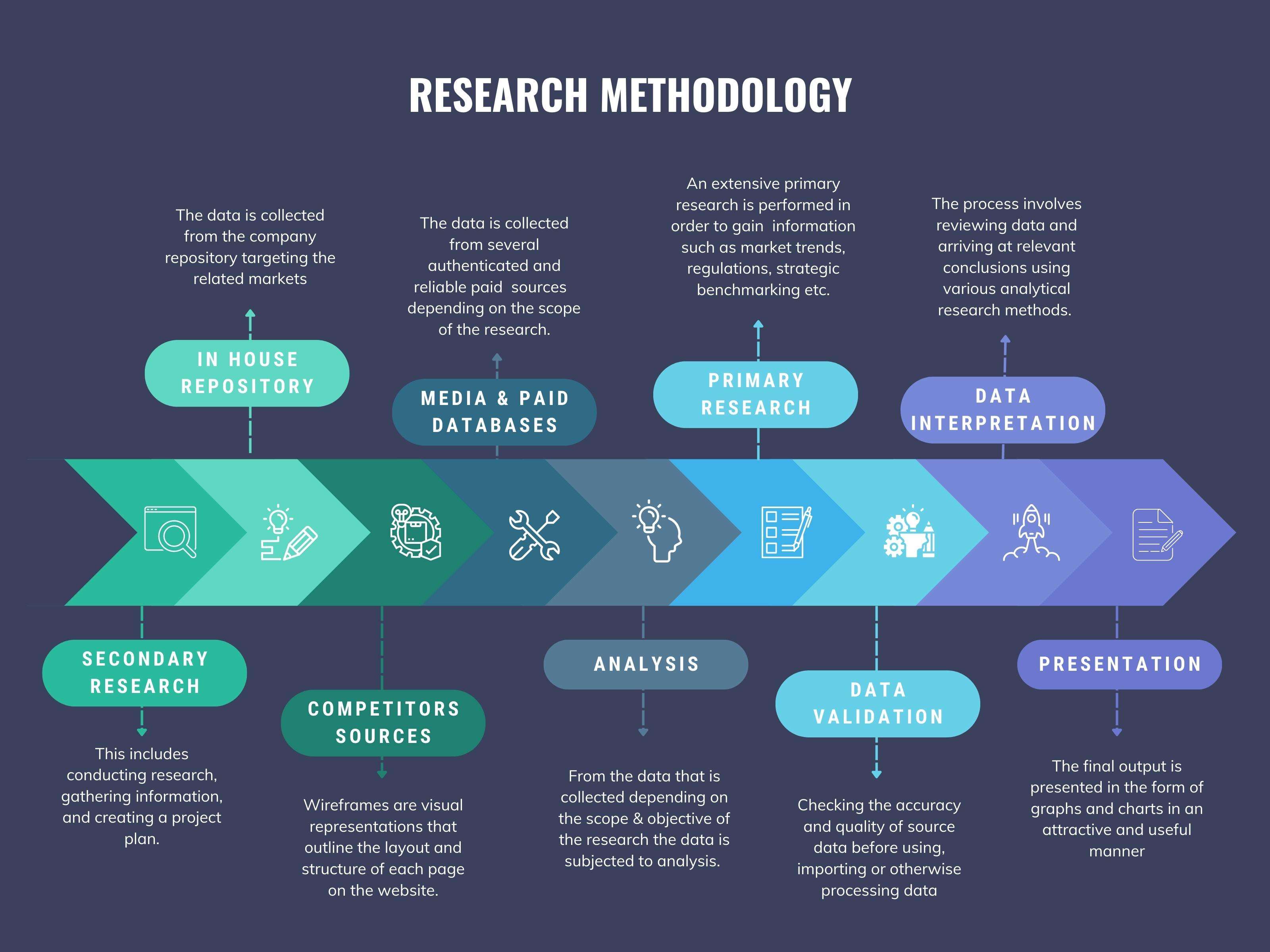
Scalable Software Defined Networking Market
Scalable Software Defined Networking Market Forecasts to 2030 - Global Analysis By Product (Mobile Core, IMS Virtualization, Operation Support System and Business Support System (OSS/BSS), Radio Access Networks, Wireline Fixed Access Networks, Customer Premises Equipment (CPE), Mobile Backhaul and Other Products), Solution (SDN Switching, SDN Controllers, Cloud Provisioning, Orchestration, Security Technologies and Other Solutions), Enterprise Type (Small and Mid-sized and Large Enterprises), End User and by Geography

|
Years Covered |
2021-2030 |
|
Estimated Year Value (2023) |
US $28.19 BN |
|
Projected Year Value (2030) |
US $184.13 BN |
|
CAGR (2023 - 2030) |
30.75% |
|
Regions Covered |
North America, Europe, Asia Pacific, South America, and Middle East & Africa |
|
Countries Covered |
US, Canada, Mexico, Germany, UK, Italy, France, Spain, Japan, China, India, Australia, New Zealand, South Korea, Rest of Asia Pacific, South America, Argentina, Brazil, Chile, Middle East & Africa, Saudi Arabia, UAE, Qatar, and South Africa |
|
Largest Market |
North America |
|
Highest Growing Market |
Asia Pacific |
According to Stratistics MRC, the Global Scalable Software Defined Networking Market is accounted for $28.19 billion in 2023 and is expected to reach $184.13 billion by 2030 growing at a CAGR of 30.75% during the forecast period. SDN, or scalable software-defined networking, is a revolutionary method of network administration that improves large-scale network infrastructures adaptability, efficiency, and flexibility. SDN, in contrast to conventional network architectures, separates the control plane from the underlying hardware, enabling centralized programmable controllers to control network resources on-the-fly. Moreover, administrators can automate and coordinate work, assign resources as needed, and apply policies uniformly throughout the network thanks to this division, which makes the network infrastructure more responsive and scalable.
According to the International Association of Computer Science and Information Technology (IACSIT), the integration of Scalable Software Defined Networking (SDN) has become increasingly pivotal in addressing the growing demands for network scalability, efficiency, and adaptability in the rapidly evolving landscape of computer science and information technology.

Market Dynamics:
Driver:
Division of data and control planes
The separation of control and data planes, which is a fundamental change in network architecture, is the driving force behind scalable software-defined networking, or SDN. These planes are closely integrated into network devices in conventional networks, which reduce their adaptability. Scalability is encouraged by the centralized control made possible by SDN's separation of them. SDN makes efficient scaling possible by centrally controlling network behavior. Furthermore, this eliminates the need for laborious manual configurations when adding or removing network devices.
Restraint:
Initial expenses of implementation
The initial implementation costs of SDN can pose a significant obstacle, despite its apparent long-term benefits. Businesses might have to pay for the installation of SDN controllers, the purchase of appropriate hardware, and employee training for the new system. Additionally, the initial outlay may be difficult, especially for startups or smaller businesses with tighter resources, which could impede the uptake of scalable SDN.
Opportunity:
Improved agility of the network
Scalable Software-Defined Networking (SDN) provides unparalleled network agility, enabling enterprises to react quickly to changing business requirements. SDN makes it possible to quickly modify network configurations through programmable interfaces, which makes it easier to integrate new services and applications. This flexibility helps businesses adapt to changing market conditions and stay ahead of the competition in sectors where demands are constantly changing. Moreover, the flexibility of SDN facilitates the adoption of creative networking tactics, encouraging ongoing enhancement and future-proofing of the network architecture.
Threat:
Security risks and vulnerabilities
The greater attack surface and security flaws brought about by the centralized control plane are among the main risks to scalable Software Defined Networking (SDN). Potential dangers include breaking into the control plane without authorization, launching malicious assaults on SDN controllers, and taking advantage of holes in the programmable interfaces. SDN disruptions, data leaks, or unauthorized network policy manipulation could result from security breaches. Furthermore, in order to guarantee the availability, integrity, and confidentiality of the network infrastructure, it is imperative that these security issues are addressed as SDN adoption increases.
Covid-19 Impact:
The COVID-19 pandemic has caused significant disruptions in a number of different sectors and has had a significant impact on global markets. Uncertainties and contractions in the economy have resulted from lockdowns, disruptions in the supply chain, and changes in consumer behaviour. Certain sectors of the economy, like technology and e-commerce, grew more quickly than others; these sectors included travel, lodging, and traditional retail. The pandemic made resilience and adaptability even more crucial, which led to a reassessment of business models and an acceleration of the digital transformation across numerous industries.
The Operation Support System and Business Support System (OSS/BSS) segment is expected to be the largest during the forecast period
In the market, the Operation Support System and Business Support System (OSS/BSS) segment has the largest market share. In the telecommunications sector, OSS and BSS are essential elements that oversee and facilitate network operations and business procedures. SDN centralization and automation in OSS/BSS improve the overall performance and nimbleness of telecom networks by handling critical tasks like network provisioning, billing, and service assurance. SDN in OSS/BSS enables more efficient network management, dynamic resource allocation, and an enhanced customer experience. Moreover, telecom operators can optimize their operations, cut costs, and react faster to shifting market demands by integrating SDN technologies into OSS/BSS.
The Cloud Service Providers segment is expected to have the highest CAGR during the forecast period
The Scalable Software Defined Networking (SDN) market's highest CAGR is seen in the Cloud Service Providers segment. Cloud service providers are depending more and more on SDN to improve the flexibility, scalability, and efficiency of their infrastructure as cloud computing continues to rule the modern IT scene. These providers can optimize network performance, allocate and manage resources dynamically, and quickly adjust to changing user demands thanks to SDN. Additionally, cloud service providers can now provide more personalized and responsive services to meet the changing needs of end users and businesses, thanks to the integration of SDN technologies.
Region with largest share:
The North American region is anticipated to hold the largest market share in the Scalable Software Defined Networking (SDN) sector. This area has been at the forefront of technological development and has seen a large industry adoption of SDN solutions. The dominance of North America in this market can be attributed to the existence of significant technology companies, research institutions, and an established IT infrastructure. Furthermore, the region has seen significant investments in SDN infrastructure from businesses looking to improve the efficiency, flexibility, and security of their networks.
Region with highest CAGR:
The Asia-Pacific (APAC) region has the highest CAGR in the market for scalable software-defined networking, or SDN. Rapid economic expansion, digital transformation, and a rise in the use of cutting-edge technologies across a range of industries have all been observed in APAC. In order to meet the region's increasing networking needs, scalable SDN solutions are in high demand due to the region's large population and growing IT infrastructure. Moreover, the adoption of SDN technologies has been fueled by significant investments made by emerging economies in Asia-Pacific, including China and India, in modernizing their network infrastructure.

Key players in the market
Some of the key players in Scalable Software Defined Networking market include Dell Technologies Inc., Hewlett Packard Enterprise Company, IBM Corporation, Juniper Networks, Inc., NEC Corporation, Arista Networks Inc., Intel Corporation, Pluribus Networks Inc., Cisco Systems, Inc., Huawei Technologies Co., Ltd., Nokia Corporation and Cumulus Networks, Inc.
Key Developments:
In November 2023, Hewlett Packard Enterprise (HPE) announced it's extending collaboration with Nvidia (NVDA) to boost its reach into generative artificial intelligence (AI). The company said the agreement will help create what it called the next series of AI-native and hybrid cloud offerings. The products will combine HPE’s hybrid cloud, supercomputing, and AI/machine learning software to enable organizations to become AI-powered businesses, the company said.
In July 2023, Dell Technologies announced that it has signed a definitive agreement to acquire Moogsoft, an AI-driven provider of intelligent monitoring solutions that support DevOps and ITOps. This transaction will further enhance Dell's AIOps capabilities, as part of its longstanding approach of embedding AI functionality within its product portfolio and as a critical component of its multicloud by design strategy.
In June 2023, IBM announced that it has entered into a definitive agreement with Vista Equity Partners to purchase Apptio Inc., a leader in financial and operational IT management and optimization (FinOps) software, for $4.6 billion. The acquisition of Apptio will accelerate the advancement of IBM's IT automation capabilities and enable enterprise leaders to deliver enhanced business value across technology investments.
Products Covered:
• Mobile Core
• IMS Virtualization
• Operation Support System and Business Support System (OSS/BSS)
• Radio Access Networks
• Wireline Fixed Access Networks
• Customer Premises Equipment (CPE)
• Mobile Backhaul
• Other Products
Solutions Covered:
• SDN Switching
• SDN Controllers
• Cloud Provisioning
• Orchestration
• Security Technologies
• Other Solutions
Enterprise Types Covered:
• Small and Mid-sized
• Large Enterprises
End Users Covered:
• Cloud Service Providers
• Enterprises
• Telecommunications Service Providers
• Academia and Research
• BFSI
• Retail and Consumer Goods
• Other End Users
Regions Covered:
• North America
o US
o Canada
o Mexico
• Europe
o Germany
o UK
o Italy
o France
o Spain
o Rest of Europe
• Asia Pacific
o Japan
o China
o India
o Australia
o New Zealand
o South Korea
o Rest of Asia Pacific
• South America
o Argentina
o Brazil
o Chile
o Rest of South America
• Middle East & Africa
o Saudi Arabia
o UAE
o Qatar
o South Africa
o Rest of Middle East & Africa
What our report offers:
- Market share assessments for the regional and country-level segments
- Strategic recommendations for the new entrants
- Covers Market data for the years 2021, 2022, 2023, 2026, and 2030
- Market Trends (Drivers, Constraints, Opportunities, Threats, Challenges, Investment Opportunities, and recommendations)
- Strategic recommendations in key business segments based on the market estimations
- Competitive landscaping mapping the key common trends
- Company profiling with detailed strategies, financials, and recent developments
- Supply chain trends mapping the latest technological advancements
Free Customization Offerings:
All the customers of this report will be entitled to receive one of the following free customization options:
• Company Profiling
o Comprehensive profiling of additional market players (up to 3)
o SWOT Analysis of key players (up to 3)
• Regional Segmentation
o Market estimations, Forecasts and CAGR of any prominent country as per the client's interest (Note: Depends on feasibility check)
• Competitive Benchmarking
Benchmarking of key players based on product portfolio, geographical presence, and strategic alliances
Table of Contents
1 Executive Summary
2 Preface
2.1 Abstract
2.2 Stake Holders
2.3 Research Scope
2.4 Research Methodology
2.4.1 Data Mining
2.4.2 Data Analysis
2.4.3 Data Validation
2.4.4 Research Approach
2.5 Research Sources
2.5.1 Primary Research Sources
2.5.2 Secondary Research Sources
2.5.3 Assumptions
3 Market Trend Analysis
3.1 Introduction
3.2 Drivers
3.3 Restraints
3.4 Opportunities
3.5 Threats
3.6 Product Analysis
3.7 End User Analysis
3.8 Emerging Markets
3.9 Impact of Covid-19
4 Porters Five Force Analysis
4.1 Bargaining power of suppliers
4.2 Bargaining power of buyers
4.3 Threat of substitutes
4.4 Threat of new entrants
4.5 Competitive rivalry
5 Global Scalable Software Defined Networking Market, By Product
5.1 Introduction
5.2 Mobile Core
5.3 IMS Virtualization
5.4 Operation Support System and Business Support System (OSS/BSS)
5.5 Radio Access Networks
5.6 Wireline Fixed Access Networks
5.7 Customer Premises Equipment (CPE)
5.8 Mobile Backhaul
5.9 Other Products
6 Global Scalable Software Defined Networking Market, By Solution
6.1 Introduction
6.2 SDN Switching
6.3 SDN Controllers
6.4 Cloud Provisioning
6.5 Orchestration
6.6 Security Technologies
6.7 Other Solutions
7 Global Scalable Software Defined Networking Market, By Enterprise Type
7.1 Introduction
7.2 Small and Mid-sized
7.3 Large Enterprises
8 Global Scalable Software Defined Networking Market, By End User
8.1 Introduction
8.2 Cloud Service Providers
8.3 Enterprises
8.4 Telecommunications Service Providers
8.5 Academia and Research
8.6 BFSI
8.7 Retail and Consumer Goods
8.8 Other End Users
9 Global Scalable Software Defined Networking Market, By Geography
9.1 Introduction
9.2 North America
9.2.1 US
9.2.2 Canada
9.2.3 Mexico
9.3 Europe
9.3.1 Germany
9.3.2 UK
9.3.3 Italy
9.3.4 France
9.3.5 Spain
9.3.6 Rest of Europe
9.4 Asia Pacific
9.4.1 Japan
9.4.2 China
9.4.3 India
9.4.4 Australia
9.4.5 New Zealand
9.4.6 South Korea
9.4.7 Rest of Asia Pacific
9.5 South America
9.5.1 Argentina
9.5.2 Brazil
9.5.3 Chile
9.5.4 Rest of South America
9.6 Middle East & Africa
9.6.1 Saudi Arabia
9.6.2 UAE
9.6.3 Qatar
9.6.4 South Africa
9.6.5 Rest of Middle East & Africa
10 Key Developments
10.1 Agreements, Partnerships, Collaborations and Joint Ventures
10.2 Acquisitions & Mergers
10.3 New Product Launch
10.4 Expansions
10.5 Other Key Strategies
11 Company Profiling
11.1 Dell Technologies Inc.
11.2 Hewlett Packard Enterprise Company
11.3 IBM Corporation
11.4 Juniper Networks, Inc.
11.5 NEC Corporation
11.6 Arista Networks Inc.
11.7 Intel Corporation
11.8 Pluribus Networks Inc.
11.9 Cisco Systems, Inc.
11.10 Huawei Technologies Co., Ltd.
11.11 Nokia Corporation
11.12 Cumulus Networks, Inc
List of Tables
1 Global Scalable Software Defined Networking Market Outlook, By Region (2021-2030) ($MN)
2 Global Scalable Software Defined Networking Market Outlook, By Product (2021-2030) ($MN)
3 Global Scalable Software Defined Networking Market Outlook, By Mobile Core (2021-2030) ($MN)
4 Global Scalable Software Defined Networking Market Outlook, By IMS Virtualization (2021-2030) ($MN)
5 Global Scalable Software Defined Networking Market Outlook, By Operation Support System and Business Support System (OSS/BSS) (2021-2030) ($MN)
6 Global Scalable Software Defined Networking Market Outlook, By Radio Access Networks (2021-2030) ($MN)
7 Global Scalable Software Defined Networking Market Outlook, By Wireline Fixed Access Networks (2021-2030) ($MN)
8 Global Scalable Software Defined Networking Market Outlook, By Customer Premises Equipment (CPE) (2021-2030) ($MN)
9 Global Scalable Software Defined Networking Market Outlook, By Mobile Backhaul (2021-2030) ($MN)
10 Global Scalable Software Defined Networking Market Outlook, By Other Products (2021-2030) ($MN)
11 Global Scalable Software Defined Networking Market Outlook, By Solution (2021-2030) ($MN)
12 Global Scalable Software Defined Networking Market Outlook, By SDN Switching (2021-2030) ($MN)
13 Global Scalable Software Defined Networking Market Outlook, By SDN Controllers (2021-2030) ($MN)
14 Global Scalable Software Defined Networking Market Outlook, By Cloud Provisioning (2021-2030) ($MN)
15 Global Scalable Software Defined Networking Market Outlook, By Orchestration (2021-2030) ($MN)
16 Global Scalable Software Defined Networking Market Outlook, By Security Technologies (2021-2030) ($MN)
17 Global Scalable Software Defined Networking Market Outlook, By Other Solutions (2021-2030) ($MN)
18 Global Scalable Software Defined Networking Market Outlook, By Enterprise Type (2021-2030) ($MN)
19 Global Scalable Software Defined Networking Market Outlook, By Small and Mid-sized (2021-2030) ($MN)
20 Global Scalable Software Defined Networking Market Outlook, By Large Enterprises (2021-2030) ($MN)
21 Global Scalable Software Defined Networking Market Outlook, By End User (2021-2030) ($MN)
22 Global Scalable Software Defined Networking Market Outlook, By Cloud Service Providers (2021-2030) ($MN)
23 Global Scalable Software Defined Networking Market Outlook, By Enterprises (2021-2030) ($MN)
24 Global Scalable Software Defined Networking Market Outlook, By Telecommunications Service Providers (2021-2030) ($MN)
25 Global Scalable Software Defined Networking Market Outlook, By Academia and Research (2021-2030) ($MN)
26 Global Scalable Software Defined Networking Market Outlook, By BFSI (2021-2030) ($MN)
27 Global Scalable Software Defined Networking Market Outlook, By Retail and Consumer Goods (2021-2030) ($MN)
28 Global Scalable Software Defined Networking Market Outlook, By Other End Users (2021-2030) ($MN)
Note: Tables for North America, Europe, APAC, South America, and Middle East & Africa Regions are also represented in the same manner as above.
List of Figures
RESEARCH METHODOLOGY

We at ‘Stratistics’ opt for an extensive research approach which involves data mining, data validation, and data analysis. The various research sources include in-house repository, secondary research, competitor’s sources, social media research, client internal data, and primary research.
Our team of analysts prefers the most reliable and authenticated data sources in order to perform the comprehensive literature search. With access to most of the authenticated data bases our team highly considers the best mix of information through various sources to obtain extensive and accurate analysis.
Each report takes an average time of a month and a team of 4 industry analysts. The time may vary depending on the scope and data availability of the desired market report. The various parameters used in the market assessment are standardized in order to enhance the data accuracy.
Data Mining
The data is collected from several authenticated, reliable, paid and unpaid sources and is filtered depending on the scope & objective of the research. Our reports repository acts as an added advantage in this procedure. Data gathering from the raw material suppliers, distributors and the manufacturers is performed on a regular basis, this helps in the comprehensive understanding of the products value chain. Apart from the above mentioned sources the data is also collected from the industry consultants to ensure the objective of the study is in the right direction.
Market trends such as technological advancements, regulatory affairs, market dynamics (Drivers, Restraints, Opportunities and Challenges) are obtained from scientific journals, market related national & international associations and organizations.
Data Analysis
From the data that is collected depending on the scope & objective of the research the data is subjected for the analysis. The critical steps that we follow for the data analysis include:
- Product Lifecycle Analysis
- Competitor analysis
- Risk analysis
- Porters Analysis
- PESTEL Analysis
- SWOT Analysis
The data engineering is performed by the core industry experts considering both the Marketing Mix Modeling and the Demand Forecasting. The marketing mix modeling makes use of multiple-regression techniques to predict the optimal mix of marketing variables. Regression factor is based on a number of variables and how they relate to an outcome such as sales or profits.
Data Validation
The data validation is performed by the exhaustive primary research from the expert interviews. This includes telephonic interviews, focus groups, face to face interviews, and questionnaires to validate our research from all aspects. The industry experts we approach come from the leading firms, involved in the supply chain ranging from the suppliers, distributors to the manufacturers and consumers so as to ensure an unbiased analysis.
We are in touch with more than 15,000 industry experts with the right mix of consultants, CEO's, presidents, vice presidents, managers, experts from both supply side and demand side, executives and so on.
The data validation involves the primary research from the industry experts belonging to:
- Leading Companies
- Suppliers & Distributors
- Manufacturers
- Consumers
- Industry/Strategic Consultants
Apart from the data validation the primary research also helps in performing the fill gap research, i.e. providing solutions for the unmet needs of the research which helps in enhancing the reports quality.
For more details about research methodology, kindly write to us at info@strategymrc.com
Frequently Asked Questions
In case of any queries regarding this report, you can contact the customer service by filing the “Inquiry Before Buy” form available on the right hand side. You may also contact us through email: info@strategymrc.com or phone: +1-301-202-5929
Yes, the samples are available for all the published reports. You can request them by filling the “Request Sample” option available in this page.
Yes, you can request a sample with your specific requirements. All the customized samples will be provided as per the requirement with the real data masked.
All our reports are available in Digital PDF format. In case if you require them in any other formats, such as PPT, Excel etc you can submit a request through “Inquiry Before Buy” form available on the right hand side. You may also contact us through email: info@strategymrc.com or phone: +1-301-202-5929
We offer a free 15% customization with every purchase. This requirement can be fulfilled for both pre and post sale. You may send your customization requirements through email at info@strategymrc.com or call us on +1-301-202-5929.
We have 3 different licensing options available in electronic format.
- Single User Licence: Allows one person, typically the buyer, to have access to the ordered product. The ordered product cannot be distributed to anyone else.
- 2-5 User Licence: Allows the ordered product to be shared among a maximum of 5 people within your organisation.
- Corporate License: Allows the product to be shared among all employees of your organisation regardless of their geographical location.
All our reports are typically be emailed to you as an attachment.
To order any available report you need to register on our website. The payment can be made either through CCAvenue or PayPal payments gateways which accept all international cards.
We extend our support to 6 months post sale. A post sale customization is also provided to cover your unmet needs in the report.
Request Customization
We provide a free 15% customization on every purchase. This requirement can be fulfilled for both pre and post sale. You may send your customization requirements through email at info@strategymrc.com or call us on +1-301-202-5929.
Note: This customization is absolutely free until it falls under the 15% bracket. If your requirement exceeds this a feasibility check will be performed. Post that, a quote will be provided along with the timelines.
WHY CHOOSE US ?

Assured Quality
Best in class reports with high standard of research integrity

24X7 Research Support
Continuous support to ensure the best customer experience.

Free Customization
Adding more values to your product of interest.

Safe & Secure Access
Providing a secured environment for all online transactions.

Trusted by 600+ Brands
Serving the most reputed brands across the world.
